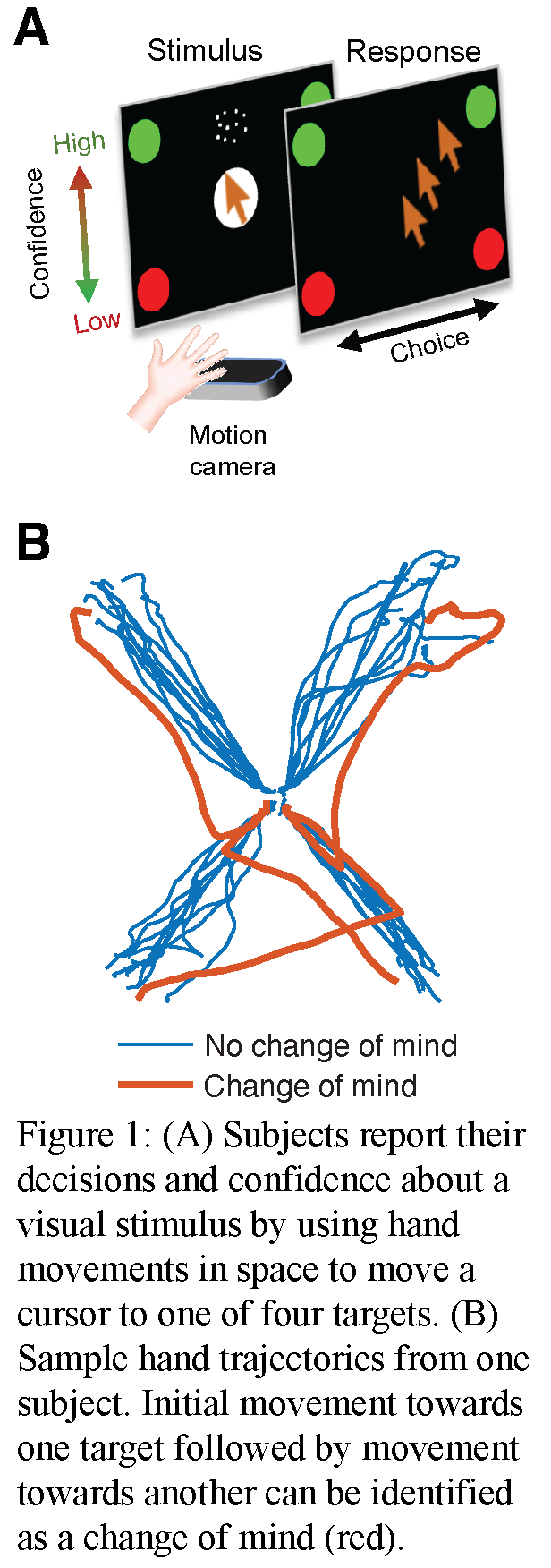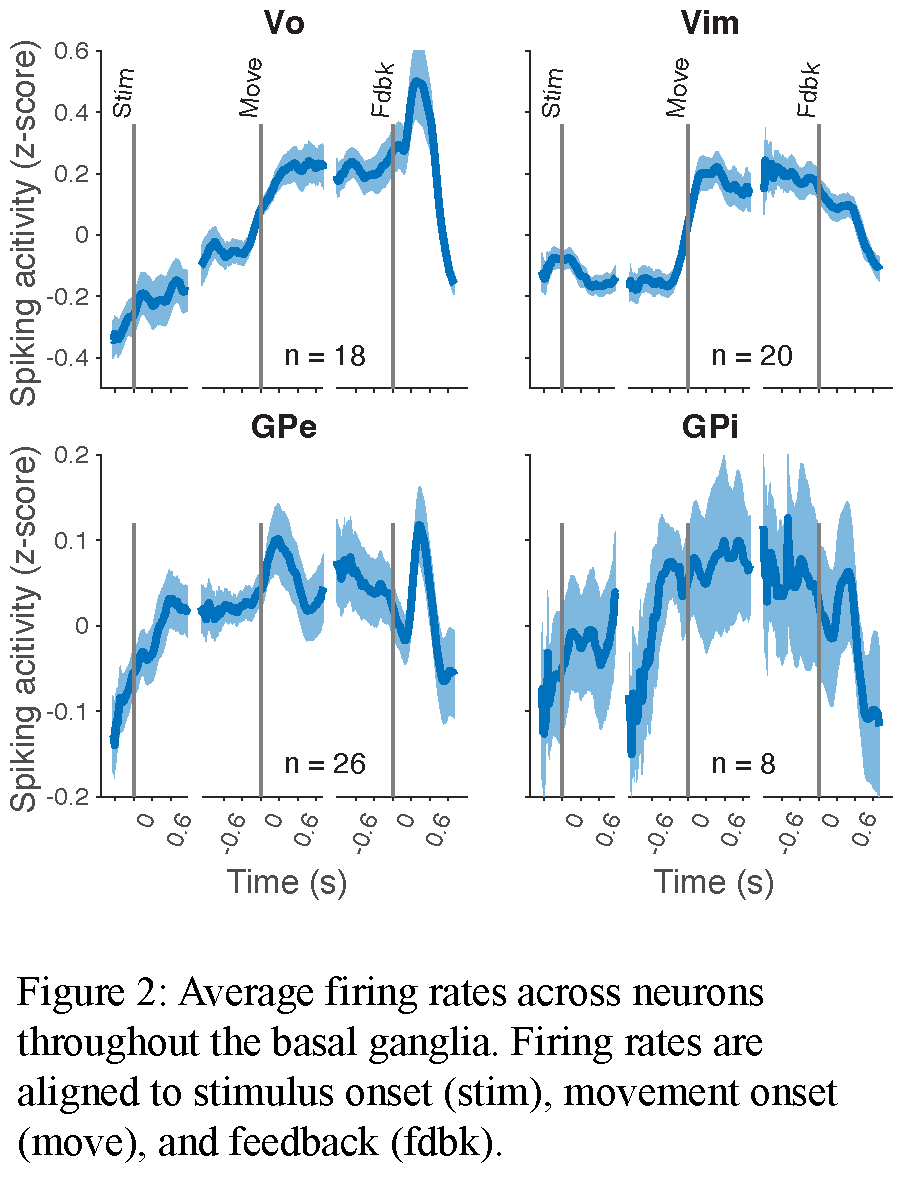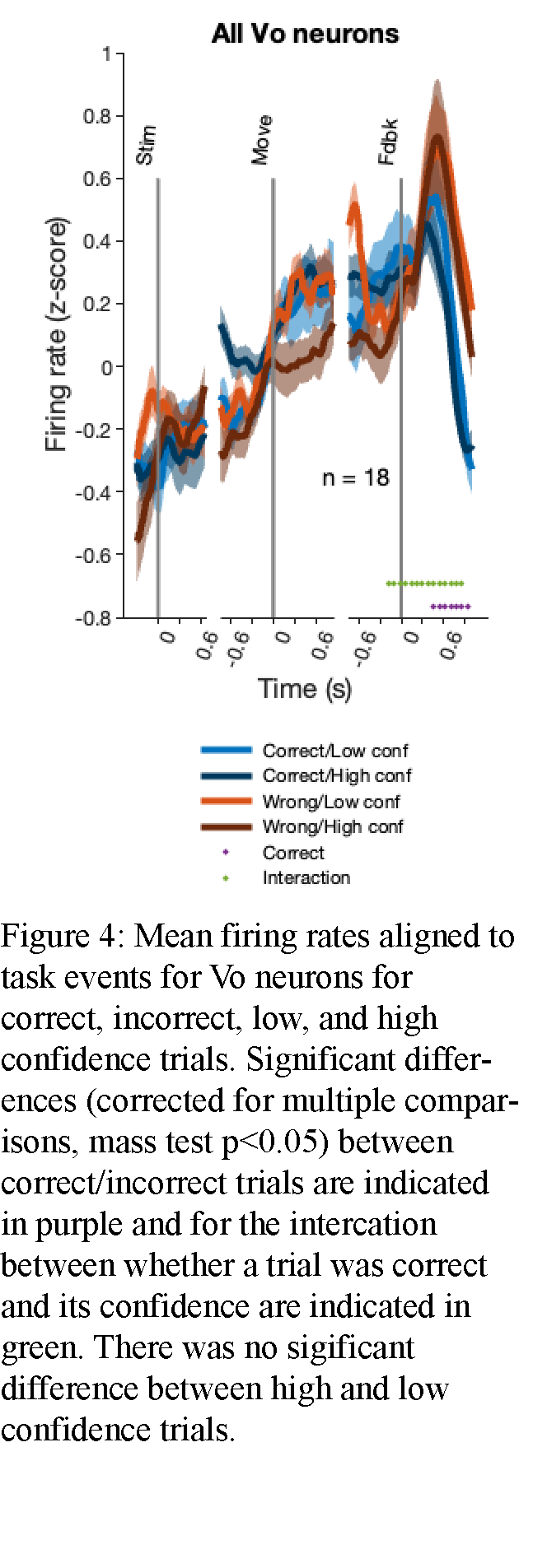Category: Neurophysiology (Non-PD)
Objective: The basal ganglia (BG) are known to play a vital role in action initiation and inhibition, studied with several simple behaviors in multiple species. While the human STN has been studied, the remaining nodes in this circuitry in humans are unexplored. We sought to determine how the BG encode action execution and confidence in ongoing actions.
Background: In classic BG models, the GPi tonically inhibits thalamocortical projections preventing movement.[1,2] GPi can be directly inhibited by the striatum or indirectly via GPe excitation, leading to movement. However, in rodents, distinct neural populations in the GPe promote movement initiation or suppression [3-5] and the striatal direct and indirect pathways are both active at the onset of movements[6]; inhibition of either can abort action sequences[7]. The STN was thought to inhibit movements[8-11], but in non-human primates, STN neurons encode action initiation, inhibition, and changes in action plans [12-14]. We hypothesized that movement plans and the confidence in whether an ongoing plan of action should continue is encoded throughout neural populations in the BG.
Method: We performed microelectrode recordings while patients (n=10) with Parkinson’s disease or essential tremor completed a decision-making task during DBS surgery. Patients performed reaching movements to one of four targets indicating their choice and confidence about a visual stimulus [figure1]. Spiking neuron data was obtained from the STN (n=44), ventrooralis (Vo, n=18) and ventral intermediate (Vim, n=20) thalamic nuclei, GPi (n=10), and GPe (n=26).
Results: Reaching movements were preceded by slowly ramping spiking activity in Vo and by a sharp increase in Vim [figure2]. Surprisingly, GPe and GPi spiking activity increased during distinct phases of movement preparation. Low confidence movements were encoded by increased firing rates across the Vim neuronal population and in individual STN neurons [figure3]. In contrast, individual GPe neurons had decreased firing rates for low confidence movements. We found neurons responsive to the outcome of each trial, with neurons in Vo encoding reward prediction errors [figure4].
Conclusion: Neuronal encoding of movements in human basal ganglia and thalamus contradict predictions of BG models. Confidence in ongoing actions and responses to their outcomes is encoded throughout multiple nodes in this circuit.
References: [1] Jahanshahi, M., Obeso, I., Rothwell, J. C. & Obeso, J. A. A fronto-striato-subthalamic-pallidal network for goal-directed and habitual inhibition. Nat. Rev. Neurosci. 16, 719–732 (2015).
[2] Cazorla, M., Kang, U. J. & Kellendonk, C. Balancing the Basal Ganglia Circuitry: A Possible New Role for Dopamine D2 Receptors in Health and Disease. Mov. Disord. 30, 895 (2015).
[3] Aristieta, A. et al. A Disynaptic Circuit in the Globus Pallidus Controls Locomotion Inhibition. Curr. Biol. 31, 707-721.e7 (2021).
[4] Gu, B. M., Schmidt, R. & Berke, J. D. Globus pallidus dynamics reveal covert strategies for behavioral inhibition. Elife 9, 1–19 (2020).
[5] Mallet, N. et al. Arkypallidal Cells Send a Stop Signal to Striatum. Neuron 89, 308–316 (2016).
[6] Cui, G. et al. Concurrent activation of striatal direct and indirect pathways during action initiation. Nature 494, 238–242 (2013).
[7] Tecuapetla, F., Jin, X., Lima, S. Q. & Costa, R. M. Complementary Contributions of Striatal Projection Pathways to Action Initiation and Execution. Cell 166, 703–715 (2016).
[8] Alegre, M. et al. The subthalamic nucleus is involved in successful inhibition in the stop-signal task: A local field potential study in Parkinson’s disease. Exp. Neurol. 239, 1–12 (2013).
[9] Benis, D. et al. Subthalamic nucleus activity dissociates proactive and reactive inhibition in patients with Parkinson’s disease. Neuroimage 91, 273–281 (2014).
[10] Obmolova, G., Ban, C., Hsieh, P. & Yang, W. Crystal structures of mismatch repair protein MutS and its complex with a substrate DNA. Nature 407, 703–10 (2000).
[11] Zavala, B. et al. Human subthalamic nucleus–medial frontal cortex theta phase coherence is involved in conflict and error related cortical monitoring. Neuroimage 137, 178–187 (2016).
[12] Isoda, M. & Hikosaka, O. Role for Subthalamic Nucleus Neurons in Switching from Automatic to Controlled Eye Movement. J. Neurosci. 28, 7209–7218 (2008).
[13] Pasquereau, B. & Turner, R. S. A selective role for ventromedial subthalamic nucleus in inhibitory control. Elife 6, (2017).
[14] London, D. et al. Distinct population code for movement kinematics and changes of ongoing movements in human subthalamic nucleus. Elife 10, (2021).
To cite this abstract in AMA style:
D. London, M. Soula, L. Pan, R. Kiani, A. Mogilner. Encoding of action plans and confidence in the human basal ganglia-thalamic circuit [abstract]. Mov Disord. 2023; 38 (suppl 1). https://www.mdsabstracts.org/abstract/encoding-of-action-plans-and-confidence-in-the-human-basal-ganglia-thalamic-circuit/. Accessed December 23, 2025.« Back to 2023 International Congress
MDS Abstracts - https://www.mdsabstracts.org/abstract/encoding-of-action-plans-and-confidence-in-the-human-basal-ganglia-thalamic-circuit/




